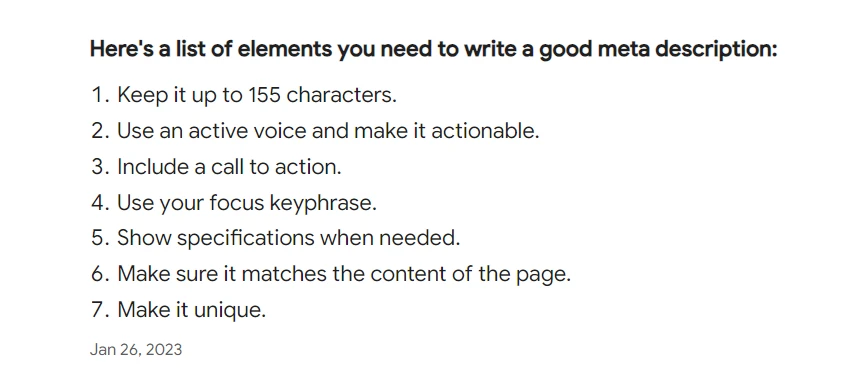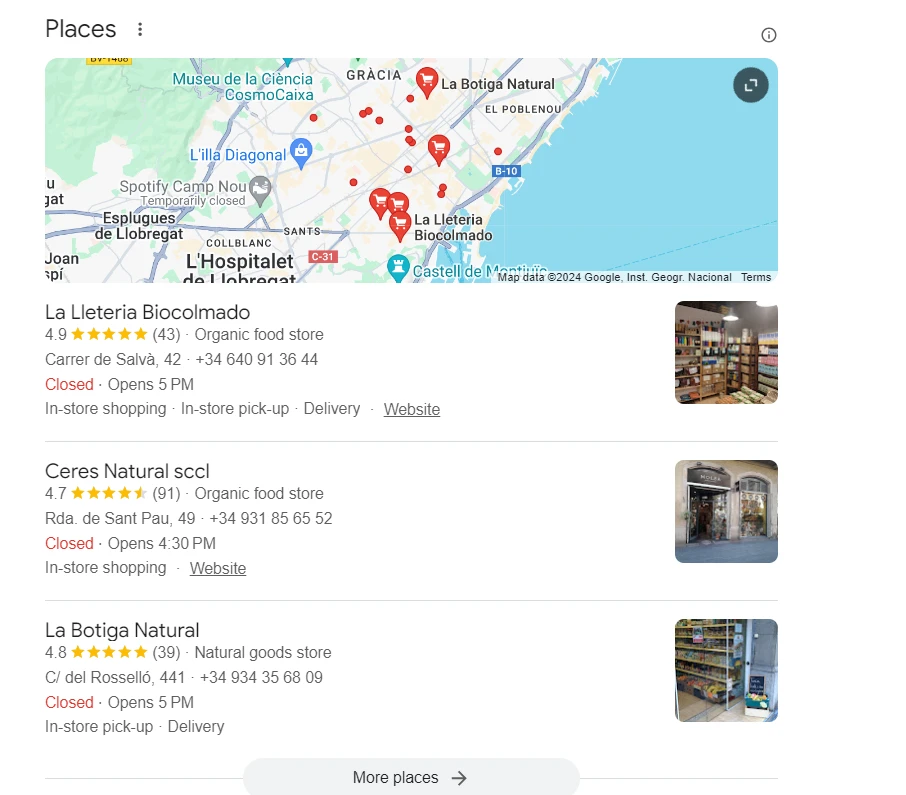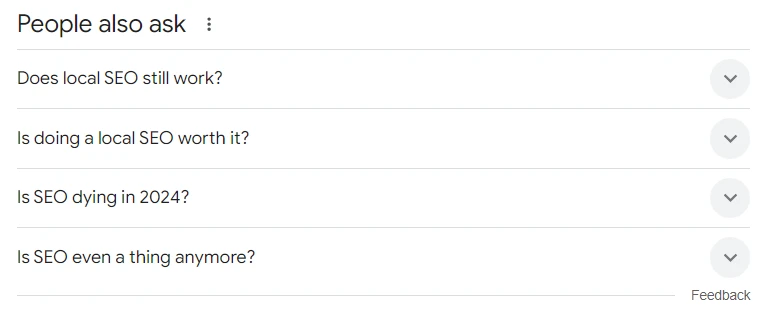Mastering SERP Features for SEO Success
According to a recent study by FirstPageSage, ranking on top of SERP in your niche generates 39.8% CTR, whilst the second and third ranking results get 18.7% and 10.2%. But to rank on top, is not anymore sufficient to win the SERP. You want to aim for the SERP features. Many SEO experts agree that optimizing your content for SERP features is the main goal of today’s SEO efforts.
We asked ourselves… if this is the case, and SERP features are growing in prominence… What makes our content worthy of ending up amongst the hotspots in the SERP Features? Stay along to get all the answers you want and those you didn’t know you need.
Understanding SERP Features
Search engine results pages used to be a list of links. Today’s SERPS are much more than that. They are tailored to create an intuitive and helpful user’s experience. Voila! Here we have it. It all comes down to the UX. Almost all. Let’s explore the nuances, shall we?
There are four types of SERP features, each with its own role in boosting your digital visibility and, of course, bringing in new clients. One of the most important insights you can have is to identify and track those SERP features that are crucial for specific business or content categories. These are the current SERP features:
Featured Snippets
Their aim is to answer the user’s question immediately. Often called “position zero,” featured snippets are those direct answers to users’ queries we all love. Displayed at the top of Google’s search results they often beat the SEO efforts targeting “just” the regular ranking factors.

Local Packs
Or Map Packs are married to local businesses. They are the key to local SEO, meaning, they appear for searches with local intent, showcasing nearby business listings with all the goodies one needs to make a decision: NAP (name, address, phone number), reviews, description, location, hours etc.
Knowledge Graphs
If you ever typed in Google “How old is Leonardo Dicaprio” you would get the Knowledge Graphs displayed. (We’re all guilty of occasional shallow searches, aren’t we?)
These are panels of information that appear on the top of search results.
They pull data from various sources to provide an overview of entities such as celebrities, movies, landmarks, and organizations.

People Also Ask (PAA) Boxes
If you try to ask Google “Is local SEO dead?” you will get those PAA boxes (spoiler alert: it is FAR from dead). PAA Boxes appear below the Featured Snippet or the Knowledge graphs, and above the regular results.
They include a series of questions by, well, the rest of us curious bunch, related to the original search query. Each provides a concise answer and a link to the source.

Targeting Specific SERP Features
The main reason why you want to tailor your content to target SERP features is to heighten the level of interaction and not only increase visibility, but become the go-to source of the topic at hand. SERP features are like the master stroke that moves you above the regular search results. And it all comes down to understanding how they work and which type of a feature suits your business.
Once you have the main reason ticked off, your web will automatically shine brighter today than yesterday and drive rivers of organic traffic to your site. In fact, SERP features will make you the go-to source for the topic at hand, not just improve your visibility.
Now, how do you hit the bull’s eye? Yes, standard SEO practices like keywords and backlinks are pretty important for most of the SERP Features targeting. And we will look at those first. But as each of the (currently) 4 SERP features has unique requirements and mostly prioritise user’s intent, we will expand on the UX and behavioural metrics further in the article.
Let’s start with understanding how you can target SERP features by blending content strategies and SEO best practices.
Goal: Featured Snippets
- Keywords: Of course those matter a lot. Use precise keywords that match common queries.
- Content structure: Structure the content with a clear, direct approach that answers those queries. Imagine describing someone the whole kitchen before you tell them where you keep the sugar. Nobody cares. They want their sugar and they want it now: sugar above the kitchen counter. This last piece will earn you a feature snippet. Use keywords, headers to break up sections, and bullet points or numbered lists to outline steps or components.
- Backlinks: Backlinks do not directly affect your eligibility to join the SERP features hotspot. Indirectly they do. Authoritative backlinks boost the overall trust of your page, which supports your place amongst the feature snippets.
- Structured Data: While not directly influencing featured snippets (in contrast to structured content), structured data helps Google understand the context of page content.
Goal: Local Packs
- Role of Keywords: Include location-based keywords in your content (description, answers to reviews) and metadata to help your site appear in local searches. Click here for a more in depth guide to local SEO.
- Google My Business (GMB): Ensure your GMB profile is up-to-date, as Google pulls most of the content for Local Packs from these listings.
- Backlinks: Local SEO benefits a lot from backlinks from local newspapers, blogs, and business associations.
Goal: Knowledge Graph
- Role of Keywords: Use keywords that are relevant to the entity being represented, such as a business, person (as mentioned previously) or place and commonly searched topics related to those.
- Structured Data: Implementing Schema.org markup is essential for helping Google create Knowledge Graph entries from your website’s content. This includes marking up contact information, social profiles, and organizational details.
- Backlinks: Yes. As mentioned, credibility matters, and more so when it comes to Knowledge graph data.
Goal: People Also Ask (PAA)
- Role of Keywords: Targeting question-based keywords and long-tail queries can increase your chances of appearing in PAA boxes. Each paragraph or section should aim to answer a specific question that users might have related to your main topic.
- Content Structure: Format answers using clear and concise language, and consider using a Q&A style on your pages to align with the types of queries that trigger PAA boxes. Just remember to integrate an organic, human style that appeals to us, readers, not just algorithms.
- Backlinks: Not as crucial for PAA, which doesn’t negate the indirect influence by having a credible, trustworthy site.
The Intersection of UX and SERP Features
The interplay between UX and SERP Features is huge. But here’s the risk: Algorithms understand a good UX based on clarity, structure, concise and succinct answers. Prioritising only that will result in mechanical and dry content, great for algorithms but very “bye-bye” for users, once they click on the SERP feature and land on your content. Keep this in mind as we move forward in the article.
User Experience as a Highly Valued Ranking Factor
Whilst your competitors might only focus on keeping the algorithm happy, you can focus on the happiness of somebody more important to your business: your people. Google’s recent updates have placed unexpected emphasis on user-centric metrics such as loading speed, interactivity, and visual stability. Websites that optimize these areas and work on superior mobile UX, are not only favored in ranking but are also more likely to be featured in SERP hotspots or mobile-centric SERPS, Mobile Top Stories.
Optimizing for User Intent
Understanding the different types of searches users engage with, is key to matching them with the right type of answer, that fit the appropriate category of SEO Features. Let’s say someone wants an informational answer by typing keywords “mobile friendly SEO”. A well structured blog would hit the spot. But if they search “mobile friendly SEO experts” they might have a transactional intent. A website with loads of backlinks solidifying the authority, well written CTA encouraging users to reach out and optimize their business for mobile users, would do well. Having this in mind can help you cover different types of intents, or focus on those, which best suit your business. Here researching what kind of keywords and long-tail keywords signal specific user intent (informational, navigational, transactional) is key.
UX Elements That Influence SERP Features
Remember that a site must be optimized for both search engines and real users. This is because you don’t want just “count” your increasing SERP Features but also convert the readers into your loyal fans and eventually customers. Finding the silver lining between succinct, clear, well structured answers, and human elements that make your content relatable, pleasant to read, is where the magic lies. That being said, the main UX elements directly influencing SERP Features are:
- Page Load Time: Fast-loading pages are more likely to be featured because… nobody likes to stand in queue.
- Content Organization: Well-organized content using headings, lists, and tables can help search engines understand and feature content more effectively.
- Mobile Optimization: As more than half of the searches are done on mobile devices, mobile-friendly content is essential for being considered for SERP features.
- Click-Through Rate (CTR): Engaging meta descriptions and titles that prompt clicks can signal to search engines that a page is valuable.
- User Engagement: Metrics like time on page and bounce rate can influence whether content is considered valuable.
- Schema Markup: Makes your site eligible for rich results like stars in reviews, prices of products, or event information. Implementing schema markup enhances the way search engines read and represent your site in the above mentioned SERPs.
Claiming SERP Features With Behavioral Metrics
In the quest to earn your spot amongst the SERP features, understanding and leveraging behavioral metrics is like finding the ultimate secret sauce that transforms your SEO game. Behavioral metrics such as click-through rate (CTR), on page time, and engagement levels are signaling to search engines that your content is not just relevant but also valuable to users. Nightwatch’s analytics and reporting tools can be used to observe how changes in SERP features impact user behavior metrics like CTR and engagement. This will help you understand the effectiveness of different content strategies aimed at winning SERP features.
Here’s how behavioural metrics influence SERP feature performance, backed by real-world data and insights.
More SERP Features = More Site Sessions And CTRs
A case study by Oneupweb highlights the direct correlation between the number of SERP features a website wins and improvements in organic site sessions and CTR. They analyzed data from five diverse clients over ten months and found that increases in SERP features consistently led to higher site sessions and impressions. Specifically, the presence of SERP features like PAA (People Also Ask) and Featured Snippets was positively correlated with these metrics, suggesting that a strategic focus on winning these features is worth the efforts.
Behavioral Metrics in Action
Taking a page from SpareFoot’s playbook, as detailed by SEO Clarity, offers another insightful perspective on targeting SERP features through behavioral metrics. SpareFoot implemented FAQ schema markup extensively across their site, which led to a notable 20.8% increase in organic CTR for those pages. This not only boosted their visibility but effectively pushed competitors further down the SERP, expanding SpareFoot’s overall SERP real estate.
4 Strategies to Leverage Behavioral Metrics
- Focus on Quality Content: As repeatedly stated: make sure that your content directly answers user queries. High-quality content engages users longer, improving time on page and potentially boosting your rankings.
- Optimize for Featured Snippets and PAA Boxes: Structure your content to answer questions directly and concisely, enriching it with human elements to satisfy both, the machine and real people. Use lists, tables and information structured appropriately to fit the style of each feature.
- Implement Structured Data: Use schema markup to help search engines understand the context of your content, making it more likely to appear in rich results discussed previously.
- Monitor and Adapt: Regularly review how changes in your content and SEO strategies affect user behavior and SERP feature performance. Nightwatch’s integration with Google Analytics, Search Console, and Google Data Studio helps to fine-tune your approach by providing deeper insights into how your content interacts with various SERP features, thereby boosting your overall SEO strategy.
The key is to remain adaptable and data-informed, as the landscape of SERP features and user behavior metrics is continually evolving.
Hot Topic: Voice Search Relevance For SERP Features
Users are increasingly turning to voice assistants for quick and conversational queries, which often pull answers directly from SERP features like featured snippets. Yes, you read that right: directly. Optimizing for voice search naturally boosts your eligibility for 2 SERP features: featured snippets and local packs. Follow below guidelines to refine your strategy and leverage both voice search and SERP features effectively.
Understanding Voice Search Behavior
Voice search queries tend to be longer, more conversational, and phrased as questions—much like how one would ask another person rather than typing into a search box. This natural language style aligns closely with certain SERP features, particularly those designed to answer direct questions. Optimizing content for Voice and SERP Features is not that different from what we discussed before. It’s really just about connecting the dots.
Keywords matter
Firstly, learn researching keywords, primarily long-tail keywords typical for voice searches in your business. They will likely be questions based and in a spontaneous, conversational tone. Organize your content to provide clear and direct answers to those questions, using the relevant keywords. Keep in mind that loads of voice searches are directed for local queries by people on the go, ready to make a purchase.
Focus On Local SEO To Own The Map Pack
“The closest hair salon with best reviews” might be the long-tail keyword for voice search, useful for the hair salons. Knowing that the hair salon could integrate this keyword in their GMB profile, because the Local Pack Feature is directly influenced by the GMB.
Direct Answers In Schema Markup
Implement structured data to help search engines understand the context of your content, which is crucial for voice search. Schema such as FAQPage, HowTo, and Event can directly feed into voice search answers.
Best For The Last: Feature Snippets
Since voice assistants often read out featured snippets in response to queries, aim to format your content to fit this criteria. By integrating the relevant keywords and understanding user intent, you can provide direct and clear answers inside a well structured content, with headers and lists to organize quality responses voice assistants can read from.
Redefining SEO: Future of SERP Feature Targeting
As we look ahead, several key trends emerge from expert predictions that could redefine how SEO professionals approach optimization strategies.
Increased Emphasis on AI and Machine Learning: Personalized UX
AI and machine learning are expected to deeply integrate into search engines, further personalizing user experiences and tailoring search results more precisely to user intents. This implies a more dynamic SERP, where features could change based on what the algorithm learns about user preferences over time AI SEO Tools.
Voice Search and Augmented Reality Integration: Anticipating New SERP Features
The trend of voice search and digital assistants is increasingly more tangible and it’s expected to grow fast. This will significantly influence SERP features. It’s possible voice search results will become directly linked to SERP features like snippets or local packs. Additionally, as AR technology advances, there might be new types of SERP features that incorporate AR elements for product visualizations and interactions AI SEO Tools.
Enhanced E-commerce Capabilities: Purchases Within SERPS
Google may expand its e-commerce features within SERPs, allowing users to make purchases directly through SERP features without needing to visit an external website. This places immense importance in SERP features targeting.AI SEO Tools
Video Content Dominance: Prioritization Of Video Content
Video content is set to play a bigger role in SEO strategies. With the steadily increasing consumption of digital video, search engines might prioritize video content even more, potentially introducing new SERP features tailored to video or enhancing existing ones like video carousels. wyzowl
The Evolution of Featured Snippets: Interactive And Visually Appealing
Featured snippets might become more interactive and visually appealing, providing users with an even richer experience directly on the search page. This would require content creators to think beyond text-based answers and work on more engaging and interactive content formats AI SEO Tools
To Secure Your Spot in SERP Features…
As SERP features continue to evolve, staying informed, updated and ready to jump along new trends will be the absolute sun of the SEO solar system. If you desire to be “the chosen one” on the SERP coveted spot, the importance of remaining adaptable can not be overstated. Whether you’re optimizing for voice search, leveraging UX and behavioral metrics for better engagement, or preparing for future trends like AI and AR in search, the key lies in proactive adaptation and ongoing learning.
To secure your spot on the SERP front page and leverage the SERP features, make sure you focus on UX, embrace new technologies as they arise, and continuously optimize as your what metrics and analysis dictate. They are the boss. Remember that UX plays a huge role in SERP features. Maybe UX is the boss? Aim to hit the sweet spot between algorithmic factors and the needs of real human beings, who, for sure need a direct and clear answer to their query, but to keep them around longer (and better yet, return for a refill) more than this will be necessary.
